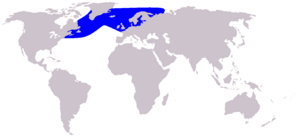White-beaked dolphin facts for kids
Quick facts for kids White-beaked dolphin |
|
|---|---|
 |
|
 |
|
| Size compared to an average human | |
| Conservation status | |
| Scientific classification | |
| Genus: |
Lagenorhynchus
|
| Species: |
albirostris
|
 |
|
| White-beaked dolphin range | |
The white-beaked dolphin (Lagenorhynchus albirostris) is a cool marine mammal that lives in the ocean. It's part of the Delphinidae family, which means it's an oceanic dolphin. These dolphins are also known as toothed whales because they have teeth!
Contents
What's in a Name?
This dolphin was first described by a British scientist named John Edward Gray in 1846. It was one of the first dolphins from its group, Lagenorhynchus, that scientists learned about. The name Lagenorhynchus comes from Latin words meaning "bottle" or "flask" and "beak" or "snout".
The dolphin's specific name, albirostris, means "white beak". This is a great way to identify them, even though sometimes their beaks can be a bit darker.
What Do White-Beaked Dolphins Look Like?
The white-beaked dolphin is a strong, chunky dolphin with a short beak. Adult dolphins can grow to be about 2.3 to 3.1 meters (7.5 to 10 feet) long. They can weigh between 180 to 354 kilograms (397 to 780 pounds).
When baby dolphins are born, they are about 1.1 to 1.2 meters (3.6 to 3.9 feet) long. They probably weigh around 40 kilograms (88 pounds).
Colors and Special Features
Their upper body and sides are dark grey. They have lighter grey patches, including a 'saddle' shape behind their dorsal fin. Their belly is light grey, almost white. Their flippers, tail (fluke), and tall, curved dorsal fin are all a darker grey.
As their name suggests, their beak is usually white. However, some older dolphins might have a dark grey beak. These dolphins have 25 to 28 teeth in each jaw. They also have more vertebrae (bones in their spine) than any other oceanic dolphin.
Baby dolphins are born with a few whiskers on their upper lip. But these disappear as they grow up. Adult dolphins, like other toothed whales, don't have any hair.
Where Do White-Beaked Dolphins Live?
White-beaked dolphins live in the cold, cool waters of the North Atlantic Ocean. They usually prefer seas that are less than 1,000 meters (3,300 feet) deep. You can find them in a wide area across the ocean. This includes places like Cape Cod and southern Greenland in the west. They also live around Iceland and from northern France to Svalbard in the east.
However, they are not fully ready for extremely cold Arctic conditions. This means they might be more at risk from predators like polar bears in very cold areas.
Common Locations
White-beaked dolphins are most often seen in four main spots. These are near the Labrador Shelf close to southwestern Greenland, around Iceland, off the northern and eastern coasts of Britain, and off the coast of Norway.
Sometimes, white-beaked dolphins are caught by accident in fishing nets. There are no different types (subspecies) of white-beaked dolphins.
Telling Them Apart
It can be easy to confuse the white-beaked dolphin with the Atlantic white-sided dolphin. But white-beaked dolphins are usually found further north. They are also typically bigger and don't have yellow stripes on their sides.
How Do White-Beaked Dolphins Live?
Scientists don't know exactly how many white-beaked dolphins there are. But they guess there are hundreds of thousands of them. More of them live in the eastern North Atlantic than in the west.
What Do They Eat?
White-beaked dolphins mostly eat fish, especially cod, haddock, and whiting.
Social Life and Communication
These dolphins are social animals. They are usually found in groups of less than ten. But sometimes, they gather in much larger groups of over a hundred dolphins!
They use special sounds to find food and talk to each other. Their sonar clicks, which help them find things, have a high frequency. Their social whistles, used for talking, can be heard by other dolphins up to 10 kilometers (6 miles) away.
Fun Facts About Their Behavior
White-beaked dolphins are very playful and acrobatic. They often ride the waves created by fast boats. They also love to jump high out of the water!
Even though they usually swim slower, they can reach speeds of up to 30 kilometers per hour (19 mph). They can also dive at least 45 meters (148 feet) deep. They often hunt for food with other large marine animals. These include killer whales, fin whales, humpback whales, and other types of dolphins.
Reproduction and Life Cycle
White-beaked dolphins likely have their babies in the summer. The calves are born the next year, usually between June and September.
Female dolphins grow to their full size around five years old. They are ready to have babies when they are six to ten years old. Males reach their full size around ten years old. They are ready to reproduce about two years later than females.
Protecting White-Beaked Dolphins
The white-beaked dolphins living in the North and Baltic Seas are protected. They are listed under Appendix II of the Convention on the Conservation of Migratory Species of Wild Animals (CMS). This means they need help to stay safe, and countries work together to protect them.
The white-beaked dolphin is also covered by another agreement. This is the Agreement on the Conservation of Small Cetaceans of the Baltic, North East Atlantic, Irish and North Seas (ASCOBANS). These agreements help make sure these amazing dolphins are protected for the future.
See also
- List of cetaceans
- Marine biology





